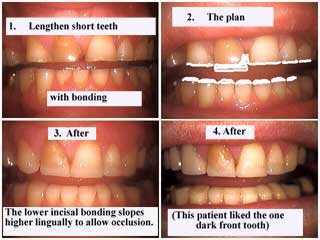The Center for Special Dentistry in New York NY offers conservative treatment for bruxism and TMJ problems with the fabrication of various types of bite guards. Our team of sixteen dentists, specialists and lab technicians work together in one office to help treat bruxism. We offer intelligent and honest diagnosis based upon 31+ years of experience. Our treatment is quick and comfortable. We use the finest materials and top labs. Before and after photos on bruxism and bite plate guards performed in our TMJ Bite Guards office. Other words to describe bruxism include teeth grinding, teeth clenching and jaw clenching.
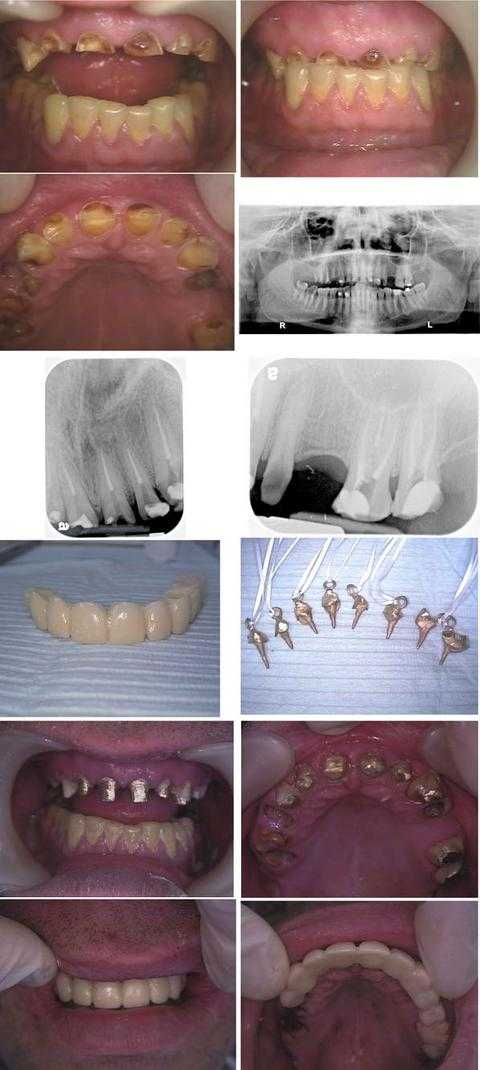
Dental Reconstruction of a Wall Street executive who suffered from dental phobia and bruxism
Total treatment time was about nine hours in two visits during one business week: Monday (four hours) and Friday (five hours). This patient could not smile in public.
In the first row of pictures, note that the bite was over-closed due to a prior history of an eating disorder, now controlled, and a current teeth grinding, bruxism, habit.
An Oral Surgery consultation with panoramic x-ray (second row) was performed prior to treatment to evaluate opening the bite to increase vertical dimension.
The third row shows x-rays taken after the Endodontist completed eight root canals on the first day on teeth #’s: 6 – 11 and 14, 15.
The fourth row shows the lab-processed 11 unit (11 tooth) temporary dental bridge and the cast gold post/cores (with Kaitlyn loops) for the root canal treated teeth.
The fifth row of pictures shows the cast gold post/cores cemented with glass ionomer.
Then the sixth row of photos shows the lab-processed temporary dental bridge in place after the oral surgeon extracted teeth #’s: 3 – 5 and 12, crown lengthening periodontal gum surgery was performed on teeth #’s: 6 – 11, and a distal wedge was performed on tooth #15.
Next a one piece porcelain-metal dental bridge – full arch roundhouse bridge – will be made after the gums heal. In addition dental implants may also be placed in the upper right jaw i.e. maxilla. A night guard is necessary to try to mitigate the force of teeth grinding. Referral for pharmacological management of anxiety was also recommended.
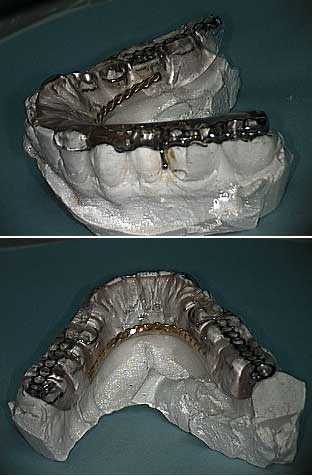
Bruxism is one of many oral habits that are seen in dentistry
Other habits include: tongue finger or thumb sucking, a tongue thrust and cheek lip or nail biting.
A mandibular stabilization appliance with a braided brass lingual reinforcement, occlusal stainless steel mesh and ball clasps. This is used to treat myalgia-myositis secondary to bruxism. Note the extension up the lingual aspect of the anterior teeth without incisor coverage. Extra oral pictures of a night guard used in the treatment of teeth grinding clenching.
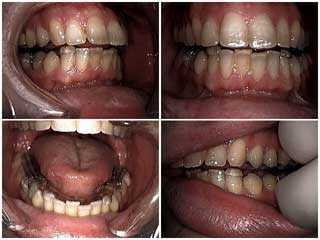
The mandibular stabilization appliance bite plate is in place on a bruxism patient
Note the cuspid rise to obtain disocclusion during lateral excursions. Intra oral pictures of a night guard used in the treatment of teeth grinding clenching.
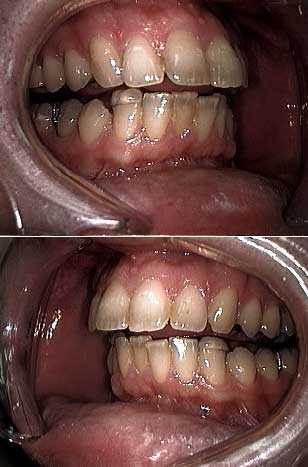
The left and right lateral view of the mandibular stabilization appliance in place on a bruxism patient
Note the cuspid rise to obtain disocclusion during lateral excursions. Intra oral photos of a night guard – also called a bite plate – used in the treatment of teeth clenching.

Six upper porcelain laminates – dental veneers – were placed to add tooth length in a bruxism patient
In the pre-op photos note the significant incisal teeth wear due to teeth grinding. A night guard for nocturnal grinding i.e. bruxism is required.
